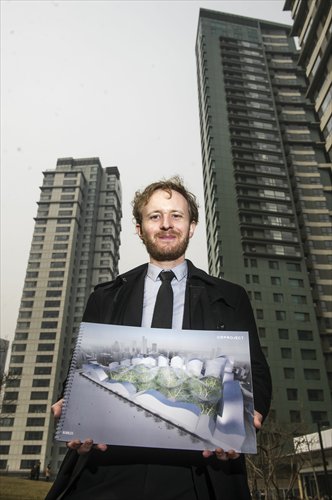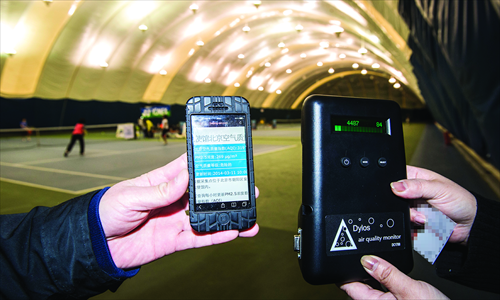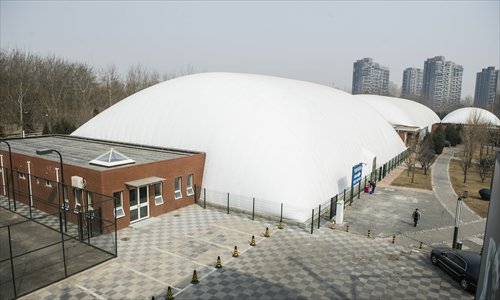Dome, sweet dome

German architect Christoph Klemmt with an artist's rendition of his proposed bubble-like structure for Beijing that would filter out air pollution. Photo: Li Hao/GT
Beijing's air pollution woes might be bad for residents' health, but for outdoor air-supported structure maker MetaSpace (Beijing) Technology smog has been good for business. The company was in a slump before 2006 amid low demand for their products, which filter out harmful air pollutants. But severe bouts of air pollution in Beijing and elsewhere in China over the past year have unlocked unprecedented market opportunities.
MetaSpace's sales and marketing director, Zhong Fan, said the company has handled more orders and enquiries over the past months than ever before. Year-on-year sales increased 100 percent in 2013.
Like disposable masks, air purifiers and even drones, air-supported structures are part of a line of "clean-air" products designed to mitigate the harmful effects of smog. They have also become a visible way for schools and other organizations to flex their environmental credentials as safe havens from the haze.
Life in the 'dome-itory'
Air-supported structures have been widely used overseas for sports and recreation venues, but Zhong said in China they have emerged as a "unique phenomenon" because of their anti-pollution capabilities.
MetaSpace's most famous client is the Dulwich College Beijing in Shunyi district. The international school made headlines in 2012 when it spent 10 million yuan ($1.6 million) on a dome that encloses its basketball courts and soccer field, allowing students to play and exercise year-round.
"The school's requirement was very specific. They wanted a dome that could keep out 100 percent of air pollution, so we installed an air filtration system especially for it," explained Zhong.
Made of synthetic fabric, the dome is supported when internal pressure exceeds external pressure. Pressurized air is pumped in via fans, which when fitted with air purifiers filter out hazardous particles.
Levels of PM2.5, the finest and most harmful pollutant particles, recorded at the school from January 14 to 18 in 2013 outside the dome were 405, 165, 118, 105 and 193 compared to 10, 3, 0, 0, 6 on the same days inside the dome.
Even though PM2.5 levels recorded on March 11 in Beijing by the US Embassy peaked at 265, deemed "unhealthy" for outdoor activities, members of the Chaoyang Sports Center were still playing tennis on dome-enclosed courts. The dome was installed last year by ASATI (Beijing) Air Domes, a subsidiary of Shenzhen-based air structure manufacturer Broadwell Technology.
Gordon Gao, general manger of ASATI, used an air quality monitor to record particle levels inside and outside the structure, which covers four tennis courts.
"The figures suggest that indoor particulate matter per cubic meter [inside the dome] is only one-tenth of that outdoors," said Gao.
In 2012, ASATI sold two domes to the International School of Beijing for more than 10 million yuan.

People play tennis inside a dome fitted at Chaoyang Sports Center, where a device indicates 'excellent' air quality. Photo: Li Hao/GT
Concerns over safety, durability
Gao, who was involved in construction of the Shijingshan district cycling velodrome used in the 2008 Beijing Olympics, said the cost of erecting an anti-pollution dome is less than 3,000 yuan per square meter, or about half the cost of a metal-structured equivalent.
In addition to its advantage of mobility, air-supported structures can be erected quickly and offer better control of air circulation and purity. But safety remains a big concern for many people.
In 2012, the dome at the Graduate School of Chinese Academy of Social Sciences in Haidian district deflated without warning, sparking panic among those exercising inside it.
Questions also remain over how the domes stand up to seasonal weather hazards in Beijing, such as torrential downpours, gales and heavy snowfall.
"We have developed a cable system to help prevent the structure from sustaining damage," said Gao. "Tedlar (polyvinyl fluoride) technology is also used to allow the dome to clean itself on rainy days."

A dome encloses tennis courts at Chaoyang Park. Photo: Li Hao/GT
Hazy hazard for public schools
Gao attributed recent booming business to orders from schools and government agencies, which account for the bulk of all clients. Some foreigners had even enquired if he could tailor domes to suit apartments, he said.
"It would be technically difficult because you need a completely enclosed space where air can't escape through windows or doors," Gao said.
ASATI recently installed a dome for the Western Academy of Beijing, the city's third international school to invest in such a structure. However, public school administrators are reluctant to follow suit of their private counterparts due to the cost of domes. Instead, many public schools have suspended outdoor sports and activities on severely polluted days.
Meng Yansong, whose 5-year-old son will soon be enrolled at a public primary school, said news of the domes at international schools left her and many other parents feeling helpless.
"Some people want to know why children from privileged families can enjoy clean air while the majority must cope with the smog. It's unfair," she said, adding she and her husband would send their son to a dome-equipped international school if cost was no barrier.
"Domes are very expensive and only a temporary solution to the pollution problem. Rather than spending money on domes, I would rather see the government use funds to tackle the root cause of air pollution," Meng added.
Beijing in a bubble
The main value of public structures is the benefit they provide all citizens rather than an exclusive group, according to German architect Christoph Klemmt. The director of Orproject Architects, Klemmt is the brains behind a radical idea to enclose all of Beijing in an anti-smog "bubble."
Klemmt, 36, has been living in China for three years and plans to stay longer. His idea for a citywide dome was partly inspired by a college classmate from India, another developing country battling air pollution.
Covering a city of more than 20 million people and over 5 million cars in a dome might be farfetched, but enclosing a large public area could prove a more practical alternative. "If we can cover a park [with the bubble], we can control its environment inside," Klemmt said.
"Buildings surrounding the park, which are connected to the controlled air system, can house apartments, offices and retail stores, but may also offer sports or medical facilities that make specific use of the healthy air," he added.
Klemmt said the purpose of a bubbled park would be to address Beijing's shortage of plants and trees needed to offset carbon emissions. "[The bubbled park] would be a greenhouse, a botanical garden in which you can have tropical plants inside," he said.
The triangular-shaped enclosure would be similar in design to the Beijing National Aquatics Center, also known as the Water Cube, and be "priced at around 3,000 yuan per square meter," according to Klemmt.
"Only if [the government] assigns certain land to be used this way can such a park be accessible for everybody," he said.
Klemmt finalized his proposal for the bubbled park a month ago, but hasn't been able to successfully pitch it to real estate developers or the government.
Indeed, convincing authorities of the project's feasibility is a task almost as ambitious as the bubbled park itself. Asked if he expects it ever get the green light, Klemmt conceded he had "no idea."
Winning the 'war on pollution'
Although constructing air-supported structures is an expensive solution to the so-called "airpocalypse," domes are increasingly appearing across China.
Earlier this month, real estate developer Hutchison Whampoa Property in Nanjing, Jiangsu Province, erected a dome near their housing project Liancheng Pinjian. The dome, equipped with an air filtering system, is the house selling office of the company, and will be renovated to an indoor stadium for residents in the future.
Worsening smog in recent years has seen the Chinese government experiment with a series of measures to clean the air, including shutting down big polluting factories or relocating them away from cities.
At this month's two political sessions, Premier Li Keqiang vowed a "war on pollution" would be at the top of the government's agenda.
One of the main weapons in this "war" was unveiled on March 10 when an unmanned drone sprayed chemicals that freezes pollutants during a test flight at an airport in Hubei Province.
Despite recent strong sales, Zhong said he was only "cautiously optimistic" about the future business for MetaSpace.